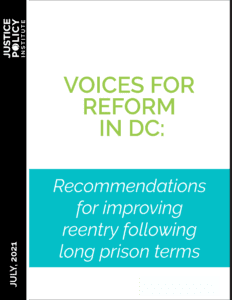| Over the past decade, the legal landscape concerning the sentencing of children under the age of 18 has evolved dramatically. There have been a series of U.S. Supreme Court decisions based on the premise that children have diminished criminal capacity and a greater capacity for change. Consequently, the Court has ruled that those who commit crimes as children should be treated differently than adults for the purposes of sentencing. Based in part on that revised legal landscape, in November 2016, the Council of the District of Columbia (DC Council) passed landmark criminal justice reform legislation: the Incarceration Reduction Amendment Act (IRAA).
According to that act, a person who has served 15 years or more in prison for an offense committed before their 18th birthday can petition the Superior Court of Washington, DC for consideration of a reduction in their sentence. The court must consider 11 statutory factors, including whether the defendant poses a danger to the community and whether the interest of justice warrants a sentence reduction. |
As of September 30, 2020, 74 people have petitioned for release under IRAA, and 65 people have been released. Most of the individuals who have been released had served decades in prison, beginning when they were still children or young adults. Transitioning from prison to the community is difficult under the best of circumstances. However, the reentry experience is profoundly more complicated for people who went to prison as children, often with limited education and significant exposure to trauma, and spent all their adult lives behind bars. The racial disparities in the criminal justice system nationwide are reflected in those who qualify for IRAA, with Black men comprising 98 percent of eligible petitioners.
All of those who are eligible, at this point, are male. They are individuals who have grown up in prison, most of whom have never lived in a free society as adults. Most are coming home in their late-30s to mid-40s without learning the necessary life skills typically acquired between adolescence and adulthood. For example, most of these individuals have never been traditionally employed and therefore lack references and professional networks; most have never had a driver’s license or rented their own apartment; they lack a credit history and basic financial literacy; and they frequently have never been in a romantic relationship as a free adult.
Providing reentry support for the IRAA population is uniquely challenging. It requires a thorough assessment to determine whether services available in the District are sufficiently aligned with the needs of those returning to the community. To answer this question, it was necessary to hear directly from impacted individuals about the experiences faced by those who have sought or are seeking relief under IRAA to determine the gaps in supports and services and the challenges faced by IRAA returning citizens. We also spoke with reentry providers and other critical stakeholders in the District. Based on these conversations, we outline key recommendations for the DC Council, the U.S. Attorney’s Office (USAO), the Federal Bureau of Prisons (BOP), the DC Jail, business leaders, social service agencies, and community partners.
This community assessment was finalized in 2020, before the approval of the Second Look Amendment Act of 2020. While the recommendations and information were researched for the population returning home under the 2016 legislation, JPI remains confident that the same set of reforms are required for those newly eligible.
